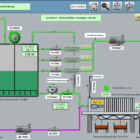The acid capacity (KS 4.3) describes the ability of water to neutralize acids. It indicates how much acid must be added to lower the pH value of the water to a certain value. The acid capacity is usually given in millimoles per liter (mmol/L) or milligrams of calcium carbonate per liter (mg/L CaCO₃).
In the practice of water and wastewater treatment, acid capacity is an important parameter for evaluating the buffering properties of water and ensuring the stability of pH values in technical processes.
Table of contents
Technical background to acid capacity
The acid capacity is essentially determined by the alkalinity of the water, which mainly depends on dissolved bicarbonates, carbonates and hydroxides. These compounds act as buffer substances and neutralize hydrogen ions introduced by acids.
The value of the acid capacity depends on the pH value at which the measurement is taken. Typically, the acid capacity is measured up to a pH of 4.3, as most bicarbonates are completely converted into carbonic acid at this value.
Significance of the acid capacity
Buffer capacity and pH stability
- The acid capacity indicates how stable the pH value of the water remains against acid additions. A high KS-value means a strong buffering effect that prevents undesirable pH fluctuations.
- Especially in biological treatment plants, such as aeration tanks or anaerobic biogas plants, stable pH conditions are essential for the growth and activity of microorganisms.
Corrosion protection
- A sufficient acid capacity prevents pH value drops that can lead to corrosion in pipes, heat exchangers and other technical systems.
Chemical requirements
- The acid capacity is used to dose acids in processes such as precipitation, softening or pH correction.
Water protection
- Acid capacity is an indicator of the ability of a body of water to neutralize external acid inputs (e.g. from acid rain or industrial wastewater) and therefore plays an important role in the ecological balance.
Applications of acid capacity in practice
1. water treatment
Acid capacity is a key parameter in drinking and process water treatment:
Lime-carbonic acid balance:
- A controlled acid capacity is required to keep the water in a chemical balance that minimizes both corrosion and scale formation.
Dosing of carbonic acid or acids:
- When softening by adding milk of lime, the acid capacity is monitored in order to dose the correct amount of precipitant.
2. wastewater treatment
Acid capacity plays a decisive role in wastewater treatment, especially in processes with biological reactors:
- The microorganisms in the activated sludge produce acids during the decomposition of organic substances. A sufficient acid capacity ensures that the pH value remains in the optimum range of 6.5-8.5.
Denitrification:
- During nitrogen elimination, acids are produced which must be neutralized by the buffering effect of the water.
3. cooling and boiler water
Cooling circuits:
- A sufficient acid capacity prevents a drop in the pH value, which could promote corrosion in cooling towers and pipes.
Boiler systems:
- The acid capacity is controlled to ensure stable water chemistry and to prevent acid corrosion.
Determination of the acid capacity
The acid capacity is measured by titration with a strong acid (e.g. hydrochloric acid) up to a pH value of 4.3. The amount of acid consumed provides information about the buffer capacity of the water.
Factors influencing the acid capacity
Geology of the catchment area:
- Water from calcareous regions has a higher acid capacity due to the content of bicarbonates and carbonates.
Anthropogenic influences:
- Wastewater discharges, especially from industry, can strongly influence the acid capacity due to acids or alkalis.
Temperature:
- Higher temperatures can influence the solubility of carbonates and thus change the acid capacity.
Optimization of the acid capacity
Addition of buffering agents
- Increase the acid capacity by adding sodium hydrogen carbonate or milk of lime.
Neutralization
- pH correction through targeted dosing of carbonic acid or sulphuric acid.
Automated monitoring
- Use of online measuring systems for continuous monitoring of acid capacity and pH value stability.
Conclusion
Acid capacity is an essential parameter in water and wastewater technology that influences the stability of the pH value and the chemical balance of the water. A sufficient acid capacity is crucial for the operational safety and efficiency of processes such as biological wastewater treatment, cooling water treatment and drinking water softening. Targeted control and optimization of acid capacity can minimize both corrosion and operational disruptions, ensuring the longevity and efficiency of technical systems.
For further information on our products, please feel free to contact us at any time!








